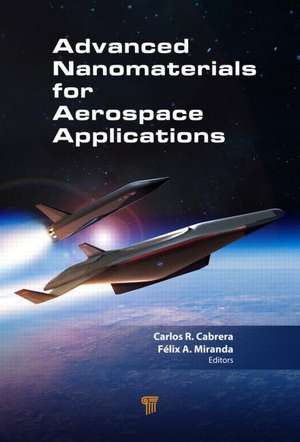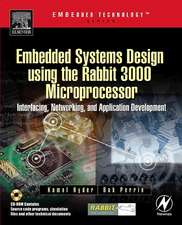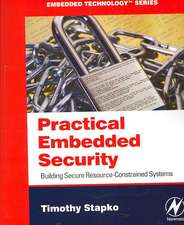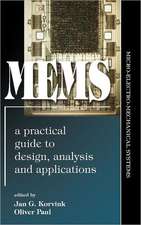Advanced Nanomaterials for Aerospace Applications
Editat de Carlos R. Cabrera, Félix Mirandaen Limba Engleză Hardback – 15 iul 2014
Preț: 657.03 lei
Preț vechi: 879.15 lei
-25% Nou
Puncte Express: 986
Preț estimativ în valută:
125.74€ • 130.79$ • 103.80£
125.74€ • 130.79$ • 103.80£
Carte tipărită la comandă
Livrare economică 14-28 aprilie
Preluare comenzi: 021 569.72.76
Specificații
ISBN-13: 9789814463188
ISBN-10: 9814463183
Pagini: 394
Ilustrații: 116 black & white illustrations, 20 colour illustrations
Dimensiuni: 152 x 229 x 25 mm
Greutate: 0.69 kg
Ediția:New.
Editura: Jenny Stanford Publishing
Colecția Jenny Stanford Publishing
ISBN-10: 9814463183
Pagini: 394
Ilustrații: 116 black & white illustrations, 20 colour illustrations
Dimensiuni: 152 x 229 x 25 mm
Greutate: 0.69 kg
Ediția:New.
Editura: Jenny Stanford Publishing
Colecția Jenny Stanford Publishing
Public țintă
Academic and PostgraduateCuprins
Advanced Sensor Nanomaterials for Aerospace Applications, Gary W. Hunter, Jennifer C. Xu, and Laura J. Evans
Challenges and Possibilities in Nanosensor Technology, Gary W. Hunter, Laura Evans, Jennifer Xu, and Azlin Biaggi-Labiosa
Nanoporous Materials in Atmosphere Revitalization, Arturo J. Hernández-Maldonado, Yasuyuki Ishikawa, Raphael G. Raptis, Bernadette Luna, Lila Mulloth, Christian Junaedi, and Subir Roychoudhury
Nanomaterials for Advanced Lithium-ion Battery Anodes, Richard S. Baldwin, James J. Wu, and William R. Bennett
Advances in Designing High Energy Cathode Materials for Li ion Rechargeable Batteries, Ram S. Katiyar, and Gurpreet Singh
Nanomaterials in Regenerative Fuel Cells, Thomas Valdes, Ileana González-González, and Carlos R. Cabrera
Nano-Technology in Advanced Life Support: Water Recycling, Michael Flynn, Eduardo Nicolau, and Carlos R. Cabrera
Nanotechnology for Nanoelectronic Devices, Félix A. Miranda and Harish M. Manohara
Brief Introduction to Nanocomposites for Electromagnetic Shielding, S. Bellucci and F. Micciulla
Epoxy Nanocomposite based on Carbon Nanotubes for Electromagnetic Interface (EMI) Shielding, S. Bellucci and F. Micciulla
Bringing NASA-relevant Nanotechnology Research into the Classroom, Ana-Rita Mayol, Christian Menéndez, Melissa Dávila, and Liz Díaz
Future Directions in Nanotechnology R&D at NASA, Michael A. Meador
Challenges and Possibilities in Nanosensor Technology, Gary W. Hunter, Laura Evans, Jennifer Xu, and Azlin Biaggi-Labiosa
Nanoporous Materials in Atmosphere Revitalization, Arturo J. Hernández-Maldonado, Yasuyuki Ishikawa, Raphael G. Raptis, Bernadette Luna, Lila Mulloth, Christian Junaedi, and Subir Roychoudhury
Nanomaterials for Advanced Lithium-ion Battery Anodes, Richard S. Baldwin, James J. Wu, and William R. Bennett
Advances in Designing High Energy Cathode Materials for Li ion Rechargeable Batteries, Ram S. Katiyar, and Gurpreet Singh
Nanomaterials in Regenerative Fuel Cells, Thomas Valdes, Ileana González-González, and Carlos R. Cabrera
Nano-Technology in Advanced Life Support: Water Recycling, Michael Flynn, Eduardo Nicolau, and Carlos R. Cabrera
Nanotechnology for Nanoelectronic Devices, Félix A. Miranda and Harish M. Manohara
Brief Introduction to Nanocomposites for Electromagnetic Shielding, S. Bellucci and F. Micciulla
Epoxy Nanocomposite based on Carbon Nanotubes for Electromagnetic Interface (EMI) Shielding, S. Bellucci and F. Micciulla
Bringing NASA-relevant Nanotechnology Research into the Classroom, Ana-Rita Mayol, Christian Menéndez, Melissa Dávila, and Liz Díaz
Future Directions in Nanotechnology R&D at NASA, Michael A. Meador
Recenzii
"Drs. Cabrera’s and Miranda’s work at the NASA-sponsored Center for Advanced Nanoscale Materials has been spectacular. This book represents an extensive collection of up-to-date studies that encourage the use of carbon-based nanostructures to solve a number of difficult technical problems associated with long-term space flights. The use of nanoscale materials promises increased efficiency of life support systems without the use of hazardous chemicals that are typically used in these applications. The book is a must-read for scientists who are involved in research on nanoscale materials for space applications."
Ramon Lugo, Director, Florida Space Institute, USA
"Materials for aeronautic and space applications present extraordinary challenges due to the stringent performance metrics that have to be met. The very readable and authoritative volume Advanced Nanomaterials for Aerospace Applications, edited by Cabrera and Miranda, addresses many of these unique material-based challenges with emphasis on nanomaterials for sensors, life support systems, regenerative fuel cells, lithium-ion batteries, robust lightweight materials, nanoelectronics, and electromagnetic shielding."
Prof. Héctor D. Abruña, Cornell University, USA
"The text is highly inspirational, easy to read and filled with data, knowhow and seemingly countless bright ideas. Much of the text lies within the grasp of undergraduates studying nano tech for the first time, also graduates and university tutors (particularly those preparing new courses). An excellent book containing 773 numbered references, there for the professional to explore."
—Peter C. Gasson, CEng, MIMechE, FRAeS, in The Aeronautical Journal, June 2015
"The text is highly inspirational, easy to read and filled with data, knowhow and seemingly countless bright ideas. Much of the text lies within the grasp of undergraduates studying nano tech for the first time, also graduates and university tutors (particularly those preparing new courses). An excellent book containing 773 numbered references, there for the professional to explore."
—Peter C. Gasson, CEng, MIMechE, FRAeS, in The Aeronautical Journal, June 2015
Ramon Lugo, Director, Florida Space Institute, USA
"Materials for aeronautic and space applications present extraordinary challenges due to the stringent performance metrics that have to be met. The very readable and authoritative volume Advanced Nanomaterials for Aerospace Applications, edited by Cabrera and Miranda, addresses many of these unique material-based challenges with emphasis on nanomaterials for sensors, life support systems, regenerative fuel cells, lithium-ion batteries, robust lightweight materials, nanoelectronics, and electromagnetic shielding."
Prof. Héctor D. Abruña, Cornell University, USA
"The text is highly inspirational, easy to read and filled with data, knowhow and seemingly countless bright ideas. Much of the text lies within the grasp of undergraduates studying nano tech for the first time, also graduates and university tutors (particularly those preparing new courses). An excellent book containing 773 numbered references, there for the professional to explore."
—Peter C. Gasson, CEng, MIMechE, FRAeS, in The Aeronautical Journal, June 2015
"The text is highly inspirational, easy to read and filled with data, knowhow and seemingly countless bright ideas. Much of the text lies within the grasp of undergraduates studying nano tech for the first time, also graduates and university tutors (particularly those preparing new courses). An excellent book containing 773 numbered references, there for the professional to explore."
—Peter C. Gasson, CEng, MIMechE, FRAeS, in The Aeronautical Journal, June 2015
Notă biografică
Dr. Carlos Cabrera is professor at the Department of Chemistry of the University of Puerto Rico, Río Piedras Campus. Cabrera’s main research area is on the development of nanocatalysts for clean energy technology such as fuel cell systems. This energy system is of importance for the development of environmentally friendly energy conversion and storage based on alcohols. Fuel cells are becoming a promising clean energy system for vehicles, portable devices, and power generators. This area of research is part of the research conducted at the Institute for Functional Nanomaterials (IFN). Through the institute, Cabrera will develop catalytic nanomaterials for fuel cell testbeds and prototypes that will be evaluated at the NASA Glenn Research Center in Cleveland, Ohio. This creation of the IFN is creating a unique opportunity for the further development of Cabrera’s nanotechnology research since new state-of-the-art instrumentations and unique partnerships will be established with nanotechnology centers located at Purdue University, University of Massachusetts, Northwestern University, Cornell University, and the Argonne National Laboratory.
Dr. Félix A. Miranda received his B.S. degree in physics from the University of Puerto Rico in 1983, an M.S. degree in physics from Rensselaer Polytechnic Institute, USA, in 1986, and a Ph.D. degree in physics from Case Western Reserve University, USA, in 1991. He is currently chief of the Antenna and Optical Systems Branch in the Communications, Instrumentation, and Controls Division. His areas of expertise are antenna technology, ferroelectric tunable microwave components, and microwave integrated circuits and devices for space and ground-based communications.
Dr. Félix A. Miranda received his B.S. degree in physics from the University of Puerto Rico in 1983, an M.S. degree in physics from Rensselaer Polytechnic Institute, USA, in 1986, and a Ph.D. degree in physics from Case Western Reserve University, USA, in 1991. He is currently chief of the Antenna and Optical Systems Branch in the Communications, Instrumentation, and Controls Division. His areas of expertise are antenna technology, ferroelectric tunable microwave components, and microwave integrated circuits and devices for space and ground-based communications.
Descriere
This book presents the applications of nanomaterials in sensors, life support systems, regenerative fuel cells, lithium-ion batteries, robust light weight materials, nanoelectronics, and electromagnetic shielding. With chapters by experts at the forefront of the field, the book examines recent research, development, and applications of nanomaterials.










